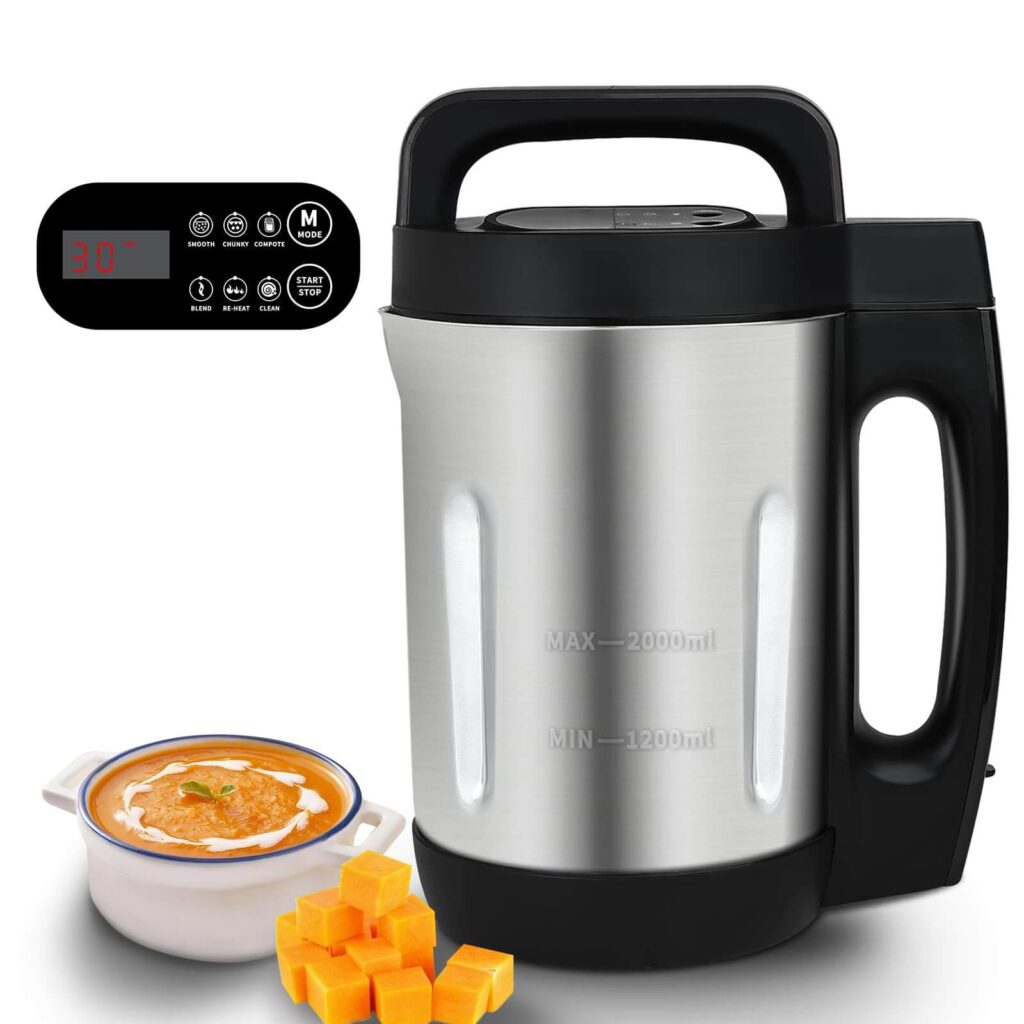Az automatikus leveskészítő bevezetése
Egy automata levesfőző egy fantasztikus konyhai eszköz, amely leegyszerűsíti az ízletes levesek készítésének folyamatát. A hosszú élettartam és a folyamatos teljesítmény biztosítása érdekében azonban elengedhetetlen a rendszeres karbantartás és tisztítás. Ez az útmutató végigvezeti Önt a szükséges lépéseken, hogy leveskészítőjét csúcsformában tartsa, és így még évekig élvezhesse a tökéletesen kevert leveseket.
A gyártó utasításainak megértése az automata leveskészítő gépben
Mielőtt használná az automata leveskészítőjét, feltétlenül meg kell ismernie a gyártó utasításait. Ezek az útmutatók konkrét információkat tartalmaznak az adott modell karbantartásáról és tisztításáról, segítik a károk megelőzését és biztosítják a készülék megfelelő működését.
Tisztítás az automata leveskészítő minden egyes használata után
Minden használat után elengedhetetlen, hogy alaposan megtisztítsa leveskészítőjét. Kezdje azzal, hogy kihúzza a készüléket a konnektorból, és hagyja teljesen kihűlni. Miután kihűlt, szerelje szét a levehető részeket, beleértve a belső edényt, a fedelet és a késeket. Ezeket az alkatrészeket meleg, szappanos vízzel, puha szivaccsal vagy ronggyal mossa ki, hogy elkerülje a felületek megkarcolását. Fordítson különös figyelmet a pengékre, ügyelve arra, hogy ne maradjanak ott ételmaradékok. Öblítse ki és szárítsa meg az összes alkatrészt, mielőtt újra összeszerelné a leveskészítőt.
Az Auotmatic leveskészítő külsejének ápolása
A belső alkatrészek tisztítása mellett ne feledkezzen meg a készülék külső tisztításáról sem. A külső felületet nedves ruhával és enyhe tisztítószerrel törölje át, ügyelve arra, hogy az elektromos alkatrészekbe ne kerüljön folyadék. A külső felület rendszeres tisztítása segít megelőzni a szennyeződések és a kosz felhalmozódását, így leveskészítője mindig újszerű marad.
Vízkőmentesítés az automata leveskészítő optimális teljesítményéért
A leveskészítő hatékonyságának fenntartása érdekében rendszeres vízkőmentesítésre van szükség. Idővel a vízből származó ásványi lerakódások felhalmozódhatnak a belső edényben és más alkatrészekben. A vízkőmentesítés történhet víz és fehér ecet egyenlő arányú keverékével vagy kereskedelmi forgalomban kapható vízkőmentesítő oldattal. Futtasson le egy tisztítási ciklust ezzel az oldattal, majd alaposan öblítse ki és szárítsa meg a kannát, mielőtt újra összeszerelné a készüléket.
Az automatikus leveskészítő éles pengéinek biztosítása
A pengék élessége kulcsfontosságú a levesek kívánt állagának eléréséhez. Kerülje a kemény összetevők, például diófélék vagy magvak használatát, amelyek idővel tompíthatják a pengéket. Ha a pengék tompulnak, fontolja meg a cseréjüket, hogy megőrizze a levesek minőségét.
Az automata leveskészítő megfelelő tárolási gyakorlata
Ha nem használja, győződjön meg róla, hogy a leveskészítője teljesen száraz, mielőtt tárolja, hogy megelőzze a penészedést. A készüléket hűvös, száraz helyen, a közvetlen napfénytől és hőforrásoktól távol tárolja, hogy meghosszabbítsa élettartamát.
Következtetés az automatikus levesfőzőről
Az automata levesfőző karbantartása és tisztítása kulcsfontosságú a hosszú távú teljesítmény és megbízhatóság biztosításához. A gyártó utasításainak betartásával, a rendszeres tisztítással és vízkőmentesítéssel, a kések éles állapotban tartásával és a készülék megfelelő tárolásával továbbra is élvezheti a finom leveseket minimális erőfeszítéssel. Egy jól karbantartott leveskészítő nem csupán egy eszköz, hanem értékes konyhai eszköz, amely leegyszerűsíti az ételkészítést.
GYIK: Automatikus levesfőzőjének karbantartása és tisztítása
1.Miért fontos a gyártó utasításainak betartása?
A gyártó utasításai konkrét útmutatást tartalmaznak az adott leveskészítő modell karbantartására és tisztítására vonatkozóan. Ezen utasítások betartása segít megelőzni a károkat és biztosítja a megfelelő működést.
2.Milyen gyakran kell tisztítani a leveskészítőmet?
Minden használat után tisztítsa meg leveskészítőjét. Ez magában foglalja a levehető alkatrészek szétszerelését és mosását, valamint a külső részek letörlését.
3.Milyen lépéseket kell követnem a leveskészítő tisztításához használat után?
Húzza ki a készüléket a konnektorból, és hagyja teljesen kihűlni. Szedje szét a levehető részeket, mossa el őket meleg, szappanos vízzel, és óvatosan tisztítsa meg a pengéket. Öblítse ki és szárítsa meg az összes alkatrészt, mielőtt újra összeszerelné.
4.Hogyan kell tisztítani a leveskészítő külsejét?
Törölje át a készülék külsejét nedves ruhával és enyhe tisztítószerrel, ügyelve arra, hogy ne kerüljön folyadék az elektromos alkatrészekbe.
5.Mi az a vízkőmentesítés, és miért van rá szükség?
A vízkőmentesítés az idővel felhalmozódó ásványi lerakódások eltávolítását jelenti, amelyek befolyásolhatják a leveskészítő hatékonyságát. A rendszeres vízkőmentesítés fenntartja a készülék optimális működését.
6.Hogyan tudom vízkőmentesíteni a leveskészítőmet?
Használjon egyenlő arányban víz és fehér ecet keverékét vagy kereskedelmi forgalomban kapható vízkőoldót. Futtasson le egy tisztítási ciklust az oldattal, majd öblítse és szárítsa meg a belső edényt, mielőtt újra összeszerelné.
7.Hogyan tarthatom élesen a pengéket?
Kerülje a kemény összetevők, például diófélék vagy magvak használatát, amelyek tompíthatják a pengéket. Ha a pengék eltompulnak, fontolja meg a cseréjüket.
8.Mi a legjobb módja a leveskészítőm tárolásának?
Győződjön meg róla, hogy a leveskészítő teljesen száraz, mielőtt hűvös, száraz helyen, közvetlen napfénytől és hőforrástól távol tárolja.
9.Mit tegyek, ha a leveskészítő leáll?
A hibaelhárítási tippekért nézze meg a gyártó utasításait, vagy forduljon segítségért az ügyfélszolgálathoz.
10.Milyen hosszú élettartamra számíthatok a leveskészítőmtől megfelelő ápolás mellett?
Rendszeres karbantartás és megfelelő ápolás mellett leveskészítője hosszú éveken át működhet, és továbbra is hatékonyan készíthet ízletes leveseket.

